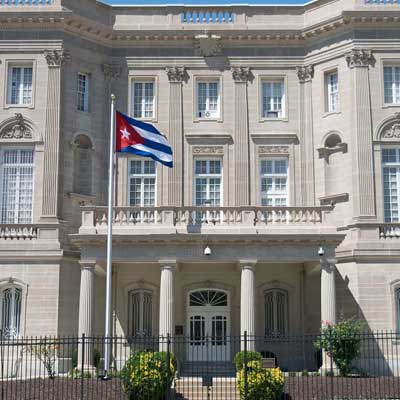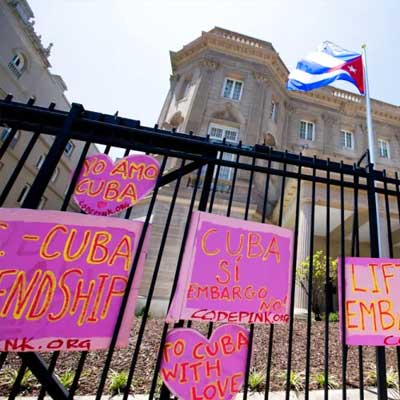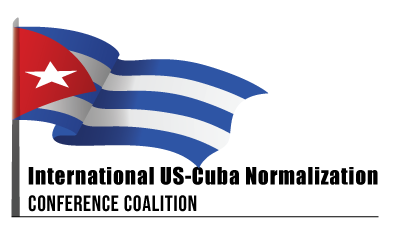YEAR
1961
April 13 – placing bombs in stockroom dolls, CIA operatives destroy the Havana Department Store El Encanto, killing one in a series of bombings in the days leading up to the CIA-organized mercenary invasion at the Bay of Pig/Playa Giron
1962
April 28 –Armed Cuban exiles attack the NYC offices of Prensa Latina, the Cuban News Agency, injuring three workers.
1964
December 11 – The Cuban Nationalist Association (CNA) fires a bazooka shell from Long Island City, Queens across the East River towards the United Nations complex in Manhattan at the moment Cuban revolutionary Ernesto Che Guevara was addressing the United Nations General Assembly. Three people were quickly arrested with charges later dismissed.
1968
May 30 and subsequent weeks – A timebomb explodes outside the studios of WNET-TV in Manhattan NYC. The terrorists claim the TV’s coverage is not anti-Castro enough. A wave of bombings followed in the next weeks, detonated at the consulates or tourist offices of Australia, Canada, France, Japan, Mexico, Spain, and Yugoslavia.
July 23 – The publisher Grove Press, which published writings and speeches of Malcolm X, Fidel Castro, and Ernesto Che Guevara, is firebombed, along with Evergreen Magazine, and the Communist Party-affiliated Jefferson Book Shop in NYC
September 16 – Cuban exiles, including later-convicted Orlando Bosch, fire a bazooka shell at a Polish freighter docked at the Port of Miami
1970
During the spring of 1970, counterrevolutionary Cuban terrorists carried out a series of armed arson attacks in Los Angeles against the Haymarket, a radical meeting place and bookstore; the offices of the Socialist Workers Party 1970 California election campaign; and the Ashgrove, a coffee house that often made its facilities available to radical causes.
1971
March 30 – A bombing of the United States Cuban Health Exchange at 41 Union Square in NYC occurred shortly after 11 A.M. A few minutes earlier an unidentified man called police headquarters and warned that a bomb would go off. The bomb blew out windows in the small, one room office on the sixth floor with fire damage. No one was in the office at the time of the blast. The Health Exchange steering committee issued a statement deploring the “ruthless attempt at intimidation obviously intended to prevent any humanitarian contact with Cuba for medical and scientific purposes.” The committee said the group had been set up by physicians, scientists, and health workers to “encourage the free interchange of medical and scientific personnel and materials.” Health Exchange steering committee members received letters signed by the “Cuban Secret Army” which saying “next we will start bombing buildings and start hurting people.”
(Health Exchange leader Margaret (Peggy) Gilpin remains today a staunch, active supporter of anti-blockade and Cuba solidarity work.)
1972
April 4 – Cuban official Sergio Perez de Castillo is killed from a dynamite explosion at the Office of Cuban Commerce in Montreal, Quebec, Canada
December -- The Cuban Secret Government (CSG) bombs a travel agency in Queens and businesses in Miami, Montreal, and New York handling packages to Cuba
1973
March 28 – A powerful bomb explodes at the Center for Cuban Studies in NYC before a pro-Cuban Revolution Exhibition ExpoCuba. Center founder Sandra Levinson was inside but uninjured (The Center for Cuban Studies/Cuban Art Space remains open and Sandra Levinson continues her life work for US-Cuba normalization and an end to the blockade.)
July 24 – The CSG bombed the headquarters of the Local 1199 Drug and Hospital Workers Union.
(now 1199SEIU United Health Care Workers East and still a stalwart force for US-Cuba normalization)
1974
January 20 – Cuban Embassy in Mexico City is considerably damaged by powerful explosion
February 4 – Cuban Embassy official in Lima, Peru suffers serious burns from a letter bomb
April 9 – The Cuban Embassy in Madrid, Spain is destroyed by a powerful bomb
May 4 – A bomb explodes at the Cuban Embassy in London, UK
May 14 – two bombs cause major damage at Cuban Consulate in Merida, Mexico
July 3 – A bomb exploded at the entrance to the Cuban Embassy in Paris, France
September 11 – Omega 7 set up by Eduardo Arocena to carry out terrorists actions against Cuba
1975
October 17 – bomb attributed to Bay of Pigs mercenary Rolando Otero explodes at Miami International Airport
December 29 – bomb attributed to Bay of Pigs mercenary Rolando Otero explodes at LaGuardia Airport in NYC
1976
April 22 – Two Cuban diplomats, Efren Monteagudo Rodriguez and Adriana Corcho, die from wounds from a bomb explosion at the Cuban Embassy in Lisbon, Portugal
April 30 – Emilio Milian, a Cuban-American radio commentator who hasn spoken out against right-wing exile terrorism loses both legs when a bomb explodes in his car
June – CIA operative Orlando Bosch founds and leads the Coordination of United Revolutionary Organizations (CORU) as an umbrella organization for organizing terrorist acts against Cuba and targets worldwide deemed friendly to Cuba
June 6 – Omega 7 bomb explodes outside the Cuban Mission to the UN
July 1 – CORU operative and CIA retainer Luis Posada Carilles plants a bomb at Costa Rica-Cuba cultural center in San Jose, Costa Rica
July 9 – CORU bomb explodes in baggage for Cubana flight in Kingston, Jamaica
July 10 – CORU bomb explodes in Cubana Airline’s office in Barbados
August 18 – CORU bombs Cubana Airline’s office in Panama
September 21 – Orlando Letelier, an official in the overthrown Popular Unity government of Salvador Allende in Chile, and his co-worker Ronnie Karpen Moffitt at the Washington, DC offices of the Institute for Policy Studies, are both murdered by a car bomb in the streets of DC. Omega 7 and CORU operatives were recruited by the Pinochet regime to carry out the assassination.
October 6 – A bomb was – after several failed attempts in other airports – smuggled onboard Cubana Flight 455 departing from Barbados. It explodes killing all 73 passengers aboard, including 57 Cubans and the member of Cuba’s Olympic fencing team.
November 7 – Cubana Airlines offices in Madrid, Spain is bombed
1978
October 5 – Omega 7 operatives explode a bomb at Madison Square Garden in NYC to protest the participation of boxers from Cuba in fights.
October 21 – Omega 7 operatives explode a bomb at the Spanish-language daily El Diario-La Prensa in NYC, following up on death threats against a Cuban American reporter investigating Omega 7 activities.
December 20 – Omega 7 takes credit for explosions in Elizabeth and Jersey City, New Jersey at the offices of Almacen el Espanol that sends food and clothing donations to Cuba
December 26 – Omega 7 operatives explode a bomb at the Venezuelan UN Mission in NYC protesting the imprisonment of Orlando Bosch for the Cubana 455 bombing
December 29 – Omega 7 claims responsibility for two bomb explosions: 1) at the Cuban Mission to the United Nations and 2) at the Lincoln Center in NYC forcing the cancellation of performances by the Cuban musical group Orquesta Aragon
1979
March 25 – Omega 7 claims responsibility for 3 bomb explosions: 1) at JFK airport in NYC in a suitcase about to be loaded on a flight, injuring four workers; 2) at the offices – for the second time – of Almacen el Espanol; and 3) in Weehawken, New Jersey at a Cuban-American community organization run by the later assassinated Eulalio Jose Negrin, a member of the “Committee of 75” who favored US-Cuba normalization.
April 28 – Antonio Maceo Brigade leader and activist for US-Cuba normalization Carlos Muniz Varela is assassinated in San Juan, Puerto Rico.
May 18 – Extensive damage at the then-Cuban Interests Section (now Cuban Embassy) in Washington, DC from a bombing by Omega 7 operatives
November 25 – Omega 7 claims responsibility for the assassination of Eulalio Jose Negrin, gunned down in front of his young son in Union City, New Jersey
October 27 – Three people injured from an Omega 7 bomb at the Cuban Mission to the UN
December 3 – Charter service between Havana and New York is cancelled after one flight following bomb threats
December 7 – Two US police officers are injured from an Omega 7 bomb at the Cuban Mission to the UN
1980
March 25 – Cuban Ambassador to the UN Raul Roa Kouri avoids certain assassination in NYC as Cuban Mission workers find an explosive devise under his car.
1981
October 21 – As the US covert “contra war” heats up against the 1979 Nicaraguan-Sandinista Revolution, two Cuban teachers, Pedro Pablo Rivera Cue and Barbaro Rodriguez are murdered along with two of the Nicaraguan peasant students in the remote Nicaraguan countryside.
December 4 – Another Cuban teacher, Aguedo Morales Reina, is assassinated in Nicaragua
September 11-12 – Omega 7 bombs destroy the Mexican Consulate in Miami and damage the Mexican Consulate in NYC
1982
September 2 – Omega 7 announces its responsibility for bombing the Venezuelan Consulate in Miami to protest the incarceration of Orlando Bosch for the Cubana 455 mass murder.
1983
December 28 – Omega 7 leader Eduardo Arocena indicted for attempted assassination of Ambassador Raul Roa and 14 bombings in Miami and NYC. The FBI now labels the group as “international terrorist” and financed by drug traffickers for services rendered.
1984
September 4 – At the trial of Omega 7 operative Arocena, his former fellow terrorist Gerardo Necuze, testifies that the organization were “enforcers” for drug dealers.
September 10 – Arocena himself is his only defense witness. He testifies as to his “American agency” training and financing in his counter-revolutionary efforts. Most explosively, and this has been further corroborated, Arocena testified that he carried “some germs” into Cuba that led to an outbreak of dengue fever in Cuba that affected some 350,000 people with 158 deaths.
September 24 – Arocena is convicted of 25 of the 26 charges against him and later sentenced to “life plus 35 years” (He was released June 25, 2021)
1985
August 22 – Luis Posada Carriles “escapes” through the front door at a “maximum security” Venezuelan prison after substantial bribes are paid
1987
August 7 – Orlando Bosch is “acquitted” in a rigged Venezuelan military court. US Ambassador to Venezuela Otto Reich applies pressure on Venezuelan government
1988
May 3 – A pipe bomb shatters the front door of the Cuban Museum of Arts and Culture in Miami, which displays art by artists who live and work in Cuba May 26 – A bomb explodes in Coral Gables, Florida at the home of Miami-Dade Community College Professor Maria Cristina Herrera and head of Institute of Cuban Studies on the same day as a scheduled conference on US-Cuba relations.
February 16 – Bosch arrives in Miami and is taken into custody for his parole violation
1989
June 23 – The US Justice Department rules that Orlando Bosch should be deported. The recommendation comes with voluminous documentation of Bosch’s terrorist crimes
1990
April 13 – One week after large protests in solidarity with Cuba by the NYC “Hands Off Cuba” Coalition, NYC cops shut down the offices of the pro-Revolution Cuban-American group Casa de las Americas, a Coalition leader, on bogus charges of building code violations
June 14 – Another bomb explodes at the Cuban Museum of Arts and Culture in Miami
July 9 – The US Justice Department reverses itself, frees Orlando Bosch and annuls his deportation order
1991
December 29 – Three members of the US-based Comandos L, which since 1962 has carried out dozens of raids and attacks in Cuba are captured in Matanzas Province, Cuba
1992
October 7 – From a speedboat offshore fires shots at the popular resort Melia Hotel in Varadero Beach, targeting Cuba’s expanding tourist industry as the severe economic consequences for Cuba kick in and deepen from the rapid political collapse of Cuba’s extensive economic exchange with the former Soviet Union (and the Eastern European states allied to the USSR).
June 11 – The Miami City Commission unanimously votes to evict Cuban Museum of Arts and Culture from its premises.
1993
January 6 – A Miami-based Federal Judge, James King, dismisses felony charges against Tony Bryant, top leader of Comandos L
January 7 – Bryant announces at a Press Conference more raids are planned and, warning tourist to stay away, says, “From this point on we’re at war, The Neutrality Act doesn’t exist.”
May 20 – Nine members of the notorious terrorist outfit Alpha 66 are arrested after US Customs agents board their speedboat and find it full of weapons.
August 24 – The same Federal Judge King in Miami dismisses the weapons charges against six of the nine.
August 25 – A jury finds the remaining three Alpha 66 terrorists not guilty of the weapons charges.
1994
May 10 – Alpha 66 members announce the formation of Comandos F4 to pursue a more aggressive, violent course of action inside Cuba.
September 4 – Molotov cocktails are thrown at the offices of Replica magazine – the latest of numerous bombings since 1974 – whose editor Max Lesnick is a leading voice for US-Cuba normalization and an end to the US blockade.
(Max Lesnick remains at age 93 an activist for US-Cuba normalization in Miami.)
Much of the documentation in this Fact Sheet comes from the essential book Cuba and the U.S. Empire: A Chronological History (Monthly Review Press, NYC) by our dear sister Jane Franklin (1934-2023).



